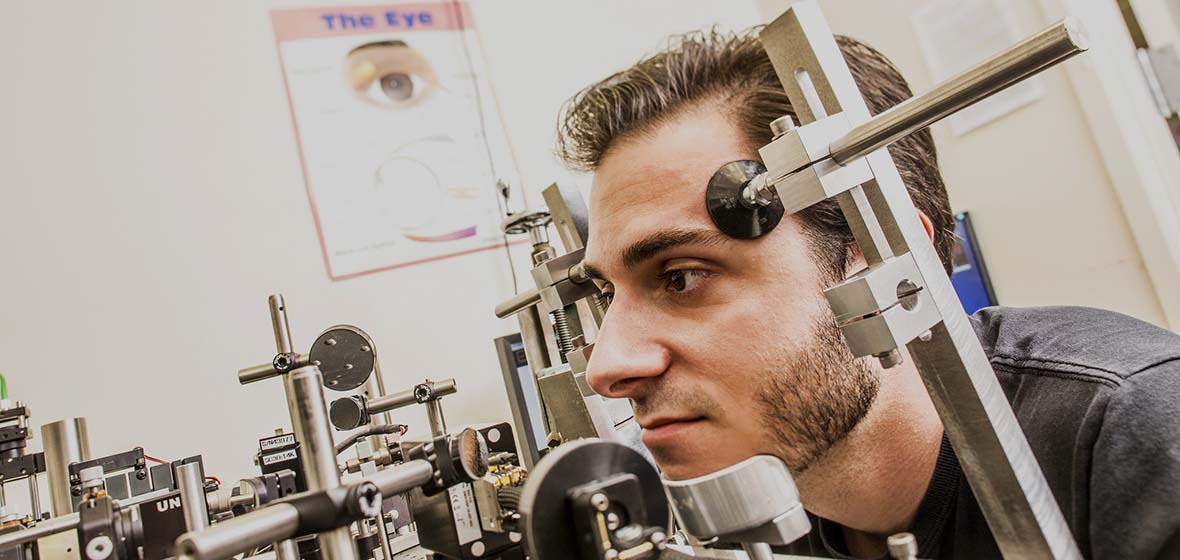Most of us take seeing for granted, but how the brain converts the light entering the eye into an understanding and experience of the world outside us remains deeply mysterious. Vision science is the study of how vision works - from optics to awareness - and is one of the most actively studied questions in modern neuroscience. Many of the leading vision scientists in the world are coming the University of Nevada, Reno campus to share some of the latest developments in the field. The OSA-Optical Society of America Fall Vision Meeting 2018 is hosted by the University's Institute for Neuroscience and Center for Integrative Neuroscience Sept. 20-23.
Nearly 250 will attend the single-track, high-quality scientific conference. Attendees include several members of the National Academy of the Sciences and visitors from at least eight different countries.
"Vision science includes everything from basic science to clinical and technological applications," said Michael Webster, director of the University's Center for Integrative Neuroscience and a fellow of the Optical Society of America, who is leading the local organization effort. "Vision scientists are exploring new technologies for giving sight back to the blind, new techniques to monitor visual diseases, and new technologies in areas such as virtual reality."
Of these exciting trends, Webster said: "The more we understand about how the brain processes visual information, the better we'll be able to help aid or restore visual losses from injury or disease or normal aging. Vision science is also playing a central role in the development of new visual media such as the explosion of virtual and augmented reality."
The OSA Vision Meeting is held annually in different locations around the country and is one of the most important conferences in the discipline. Sessions and activities take place in the Joe Crowley Student Union and Davidson Math and Science Center, and include several invited symposia, three contributed talk sessions and contributed poster presentations.
As a prelude to the conference, free guest lectures - open to University of Nevada, Reno faculty, staff and students - are featured Thursday, Sept. 20, 2-4 p.m. in the Joe Crowley Student Union Theatre. Supported by the University's Integrative Neuroscience COBRE grant through the National Institutes of Health, these lectures feature renowned visual-system experts Lynne Kiorpes of New York University and Colin Clifford of University of New South Wales.
A highlight of the conference is the presentation of the OSA Edgar D. Tillyer Award to Professor Marty Banks of UC Berkeley, who also delivers the Tillyer Lecture. Dr. Banks is one of the world's foremost experts on depth perception and 3D displays, and is a regular consultant to the film and virtual reality industries on how to create more realistic and immersive experiences to viewers by mimicking how the brain senses depth in the real world.
Bringing the OSA Vision Meeting to Reno draws attention to the breadth and depth of vision-science work happening across the University of Nevada, Reno. Over the past decade the University has created both undergraduate and graduate degree programs in neuroscience and greatly expanded the neuroscience faculty. Many of these faculty members have research programs in vision science. Across the campus, more than two dozen faculty members are conducting research that pertains to some aspect of vision. This includes faculty in the Colleges of Engineering, Liberal Arts, Sciences and Biotechnology, Agriculture and Natural Resources, as well as the University of Nevada, Reno School of Medicine and School of Community Health Sciences. The Department of Psychology alone now includes 10 labs concentrated on various facets of human vision. All are members of the interdisciplinary Graduate Program in Integrative Neuroscience, which includes 60 faculty members whose work spans cognitive, cellular-molecular and computational aspects of neuroscience.
University faculty and students in vision science and neuroscience benefit from the shared core facilities provided through the Center for Integrative Neuroscience, which has been awarded more than $20 million through the NIH-COBRE grant. This includes equipment, technical support and training for a variety of neuroimaging tools for noninvasively monitoring brain activity while people perform different visual or cognitive tasks. These methods allow researchers to characterize the neural operations involved in seeing at different stages along the visual pathway. The center has also recently developed a new core facility to support research utilizing virtual and augmented reality. The core is directed by Dr. Eelke Folmer, a recognized expert in virtual reality, who is also chair of the university's Department of Computer Science and Engineering.
Webster has been investigating human vision at the university since 1994, and his work has been funded throughout by the National Eye Institute. He was recently named the 2019 Verriest Medalist, an award presented by the International Colour Vision Society for outstanding contributions in the field of color vision.
OSA was founded in 1916 and, over its century-plus history, has evolved into a global enterprise. Through scientific, technical and educational initiatives, OSA promotes the generation, application and archiving of all aspects of knowledge in optics, photonics and the visual system, and includes a number of Nobel laureates among its members.












